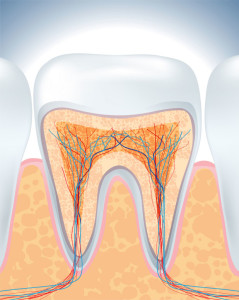 Here at OMSH we believe in doing everything we can to help preserve your existing teeth in order to maintain your oral health. The loss of a tooth can have a severely negative impact on your overall oral health, so when a tooth has been damaged either by trauma or decay we will often opt for root canal therapy. A root canal is a restorative dental procedure that can save an existing tooth from needing to be removed. The procedure involves the removal of decay as well as biological material from the tooth.
Here at OMSH we believe in doing everything we can to help preserve your existing teeth in order to maintain your oral health. The loss of a tooth can have a severely negative impact on your overall oral health, so when a tooth has been damaged either by trauma or decay we will often opt for root canal therapy. A root canal is a restorative dental procedure that can save an existing tooth from needing to be removed. The procedure involves the removal of decay as well as biological material from the tooth.
Why would I need a root canal?
As mentioned above a root canal is a last ditch effort to save a tooth that would otherwise need to be removed. When teeth are removed it can have an extremely negative impact on your overall oral health. When you lose a tooth your bite can change causing TMJ pain and the potential for chipping and cracking of teeth.
Bone loss in the jaw often follows the loss of a tooth. When bone is lost in the jaw it can easily lead to more extensive tooth and bone loss. Having a root canal allows you to keep your original tooth and avoid all the downfalls of losing a tooth. Further, it is much easier and more cost effective to have root canal therapy done than it would be to replace the tooth with a permanent or removable dental appliance like a bridge or implant.
When the tooth has been deeply affected by decay, where the decay has reached the inner portions of the tooth, like the pulp or the root, we will perform a root canal to save the tooth.
Are there alternative options to a root canal?
If the doctor suggests a root canal in order to save your tooth then the root canal is the best option for you. Unlike other procedures that offer patients a variety of options to choose from, root canal therapy is unique in its ability to save a tooth.
The Procedure
Root canal therapy is a fairly straight forward procedure. To understand how a root canal works it helps to know the four layers (or parts) of a tooth. If you were to look at a cross-section of a tooth you would see three layers surrounding the inner most core of the tooth – the root.
The Layers of a Tooth
The outer-most layer of the tooth is something we are all familiar with – the enamel. Enamel is the hard, white, outer layer of the tooth. Enamels role is to protect our teeth from environmental hazards as well as the biological hazards of tooth decay and plaque.
Beneath the enamel of the tooth is the dentin, which comprises a large portion of the tooth. Dentin is not quite as hard as the enamel, but gives the tooth its structure. Below the dentin is the final layer of the tooth – the pulp. The pulp of the tooth is biological material that is much fleshier than the hard, outer layers of the tooth. The pulp surrounds and protects the nerve of the tooth.
When a root canal becomes necessary, it is usually because decay has reached the pulp and the root of the tooth. The goal is to remove these inner layers of the tooth to protect it from further damage.
Tooth Preparation
To prepare the tooth for root canal therapy we will use a special drill to reach the inner most layer of the tooth, the pulp. Once we can access the pulp we will begin removing it.
Removing the Pulp and the Root
The procedure to remove the pulp and root of the tooth is a delicate one. We will carefully and thoroughly remove the biological material using a tool called a bur. This is the most critical part of the procedure so we make sure to take our time. The pulp and root are removed to ensure that no biological material is left in the tooth. Once this material is removed from the tooth there will be nothing left within the tooth for decay to act upon.
Once we are finished manually removing the pulp from the tooth we will irrigate the tooth with a cleaning solution that ensures no bacteria is left within the cavity. We will then fill the cavity with an inert material known as Gutta-Percha. This Gutta-Percha helps the tooth to maintain its structure.
We finish the procedure by filling the access hole that same way we would a filling – with a tooth colored composite material.
Post Procedure
You will be able to eat within several hours of the completion of the procedure. It is important to take good care of your teeth after the procedure by brushing at least two times a day and flossing before bed.
contact us today to schedule an appointment. We recommend you see us at least twice a year for routine cleanings and examinations.
